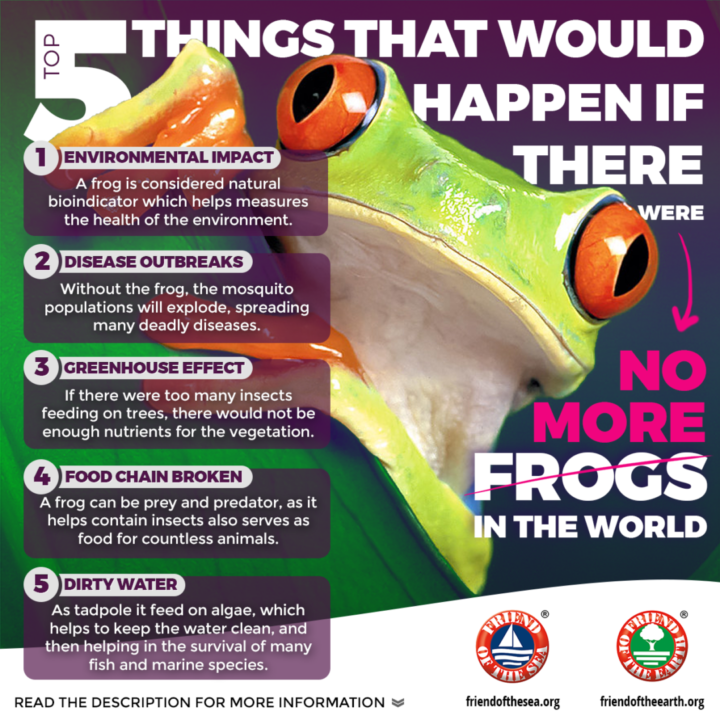Frogs are cold-blooded members of the amphibian group. They lay eggs in water. Since their larval stage, tadpoles have tails and internal gills that allow them to survive underwater. They develop lungs at a mature stage and thereby can live both in terrestrial and aquatic habitats. Their skin is covered with mucus which assists in skin protection and keeping it moist. The frog population serves as a good indicator of ecosystems’ health as they are responsive to atmospheric alteration. They live in a variety of environments including tropics and subtropics while the tropical rainforest has the greatest abundance of this species.
The Problem
Various factors are playing roles towards the downward trend in the frog population in the world. The most prominent of these are unsustainable agriculture and aquaculture practices. Besides, biological resource usage such as hunting, trapping, logging, and wood harvesting, fishing and harvesting aquatic resources also contribute highly towards this cause. Human activities such as industrialization, urbanization, tourism, mining, oil/gas drilling, constructing dams/roads/railway, etc. are among the causes that are having a serious impact on the frog population. Other threats arise from invasive non-native and problematic species and various pests and pathogens, such as the chytrid fungus.

Environnemental Consequences
According to IUCN data, there are 6160 species of frogs in the world. Among them, 41.3%, 29.5% and 28.8% of the total species are terrestrial, aquatic and amphibian respectively. 2406 of these species are currently tumbling in numbers. South America is home to 839 of these species which is highest followed by South and South East Asia amounting to 543. Besides, the Sub-Saharan region has 471 of these species. Major countries of concern are Colombia, Madagascar, Ecuador where the number of species with declining frog population is 281, 243 and 208 respectively. Other noteworthy countries are Brazil (197), China (181), Indonesia (158), Peru (151), Malaysia (140), Mexico (131), India (115) and Vietnam (113).
Among all the species, 8% and 13.4% are enlisted as critically endangered and endangered respectively whereas 4.4% are vulnerable which is a significantly dreadful situation considering their importance in the ecosystem as both predator and prey. Colombia, Mexico, Ecuador, and Haiti are at the top of the list harboring critically endangered species which account for 66, 45, 44 and 31 respectively. 0.5% of the total species became extinct amounting to 30 where 20 of those were from Srilanka.
Possible Solutions - How to save the frogs
To save the critically endangered and endangered frog species, it is necessary to take multiple actions. First and foremost, the natural breeding cycle and propagation of frogs need to be ensured by conserving their current habitats. This could be achieved by taking policies and strategies of industrialization, urbanization, and farming which are eco-friendly especially towards the frog population. Besides, habitat restoration through constructive management of national parks, wildlife sanctuaries, protected in-land water bodies and introducing such facilities in countries where there is none is essential towards this end.
Moreover, a control mechanism against pathogenic diseases as well as invasive alien species employing scientific discovery is also important. Similarly, ex-situ conservation practices such as captive breeding/artificial propagation, genome resource bank formation would have a positive impact on frog growth. The spotted tree frogs which were being decimated by amphibian chytrid fungus were saved from extinction by a team of scientists from Amphibian Research Centre in Melbourne through captive breeding and they have been re-introduced in the Kosciuszko National Park after 15 years.
The convention on International Trade in Endangered Species (CITES) is an agreement between 150 countries that prevents trading of wild animal species if their survival is threatened and these regulations need to be implemented properly as frogs are consumed as human food in many places. Other national and local legislations need to be introduced as well. Last but not least, raising awareness through formal education, training, and engagement with various bodies within the society is vital to encounter these prevailing threats towards the frog population.
WSO’s activities and initiatives
WSO Friend of the Sea and Friend of the Earth projects will take steps in the following areas as part of their present agenda of certifying products from sustainable agriculture and aquaculture practices:
- Work with decision-makers from various hierarchies in government, non-government sectors specifically those from South America and South and South East Asia by informing them about the current deteriorating status of the frog population.
- Contact with industrial, agricultural, urban development sector business owners and urge them to take eco-friendly policies which would benefit the frog species.
- Organize or participate in various seminars, symposium and conferences to raise awareness among local communities about the conservation of frogs.
- Launch campaign in change.org or similar platforms for saving critically endangered frogs.
Call to action
- Choose Friend of the Sea or Friend of the Earth certified products and services.
- Sign Friend of the Sea and Friend of the Earth Change.org petition
- Choose leaders of parliament who care about environmental sustainability such as saving threated frog species and are willing to intervene by introducing relevant legislations. Authorities at the National Park Laguna Blanca undertook an action plan to control invasive fishes at White lagoon in 2007 to protect the population of Patagonia frogs, an endemic species to north-western Argentina. Similar models need to be promoted elsewhere.
- Promote establishment of captive breeding and national parks where there is none yet.
- Fund conservation initiatives by biologists, evolutionists, pathologists who work on frogs.
How you can help protect the frogs
- Choose Friend of the Sea or Friend of the Earth certified products and services.
- Sign Friend of the Sea and Friend of the Earth Change.org petition
- Choose leaders of parliament who care about environmental sustainability such as saving threated frog species and are willing to intervene by introducing relevant legislations. Authorities at the National Park Laguna Blanca undertook an action plan to control invasive fishes at White lagoon in 2007 to protect the population of Patagonia frogs, an endemic species to north-western Argentina. Similar models need to be promoted elsewhere.
- Promote establishment of captive breeding and national parks where there is none yet.
- Fund conservation initiatives by biologists, evolutionists, pathologists who work on frogs.









